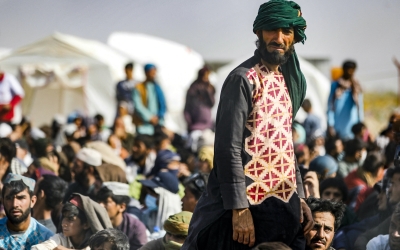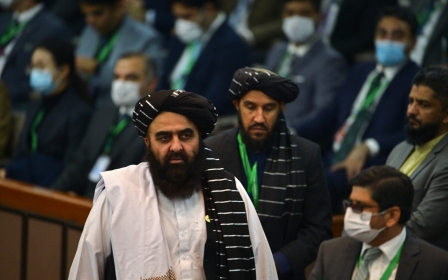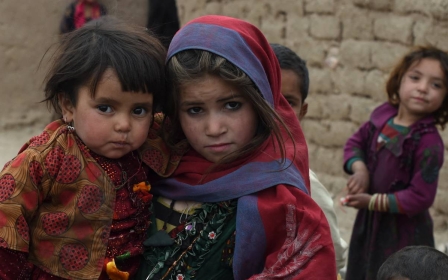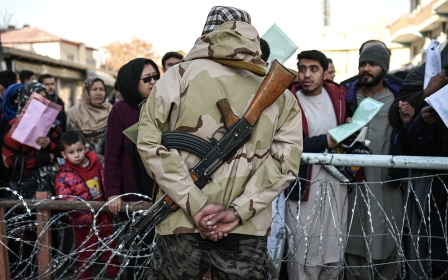Afghan girls move to Iran to defy Taliban's education ban

An increasing number of Afghan families have found refuge in neighbouring Iran after the Taliban government reneged on its promise to allow girls to go to school in March.
It has now been more than eight months since girls in Afghanistan were allowed to attend secondary school.
Initially kept out of the classroom for six months because of the turmoil in the country following the August 2021 US withdrawal and the Taliban's return to power, girls were repeatedly told they would be able to recommence their education at the start of the new school year in March.
'They would look at the girls and say: "Go home. Even studying this much should be enough for you all"'
- Nilofar, teacher in Herat
But on Wednesday 23 March, as thousands of teenage girls across Afghanistan headed back to school, the Taliban reversed the decision at the last minute. Taliban guards posted outside schools barred their entry, leaving students in tears as they headed back home with books in hand.
“They would look at the girls and say: ‘Go home. Even studying this much should be enough for you all',” recalled Nilofar, 31, a teacher in the western province of Herat.
IS attacks on schools
Sources who spoke to Middle East Eye in the city of Mashhad, northeast Iran, said that enrolment at schools catering for Afghan refugees had increased over the last six weeks, particularly for young girls.
A principal at one such school said that, although education might not be the primary factor pulling people towards Iran, it was a significant one.
“There are major issues with insecurity and the economy," the principal, who did not want to be identified by name, said.
"But if education isn’t the number one reason for these families to come here, it’s definitely high up.”
In recent months, forces claiming allegiance to the Islamic State (IS) group have staged increasingly brazen attacks on schools, education centres and places of worship in several provinces of Afghanistan.
The attacks came despite the Taliban’s repeated claims that once they came to power and the US-led occupation had ended, safety and security would finally return to the nation.
Yet one international organisation has said that nearly 20 million Afghans, or 47 percent of the population, were facing food insecurity due to the economic downturn, drought, aid cutbacks and Washington’s withholding of billions in Afghan assets following the Taliban’s return to power.
Zainab Sajadi, the principal at a non-governmental school for Afghan refugees in Mashhad, told MEE that the enrolment of undocumented students had risen since the Taliban takeover last summer.
“We received hundreds of new students. Our classrooms are completely full,” Sajadi, 41, said.
“We don’t have enough chairs. Some students stand in class, others have to share their chairs.”
Teachers doing extra shifts
Sajadi said the school had started to hold three different shifts of classes a day, with the teachers doing extra lessons voluntarily and without additional pay.
But Sajadi feared that no matter how many steps they took, it would never be enough to meet the outsized demand.
“Even If we keep teaching three shifts a day and continue enrolling students, there will still be thousands of other students who will be unable to attend school,” she told MEE.
'They are the most intelligent students in our school. I can see just how much they are starving for education'
- Zainab Sajadi, teacher in Mashhad, Iran
Sixty percent of the pupils in Sajadi's school are Afghan girls.
“They are the most intelligent students in our school," she said. "I can see just how much they are starving for education.”
But the journey to Iran for Afghans is fraught with dangers and difficulties.
Paying smugglers to get you across the border can cost upwards of $400 per person, and with bank restrictions on weekly withdrawals in place and millions of people unemployed or on severely reduced wages since the Taliban returned to power, such fees are beyond many Afghans.
Furthermore, Iranian border guards have been accused of shooting dead or torturing Afghan migrants. Tehran was notably one of only two governments (the other being Islamabad) to never suspend the deportation of Afghans as the Taliban was inching closer to Kabul last summer.
For those Afghans who do make it into Iran, there is also the abuse, intimidation and racism they face from both the government and the general Iranian population.
This is why hundreds of Afghan families have relocated to a handful of areas in their own country where teenage girls have been able to return to school.
Increasingly harsh dress codes
One such place is Mazar-i-Sharif, the fourth-largest city in Afghanistan and the capital of the northern province of Balkh.
There, dialogue between the schools and the Taliban has seen girls able to continue their education. However, schools in Balkh and elsewhere have been threatened with closure if they refuse to comply with increasingly harsh dress codes.
“The requirements on hijab are getting tougher day by day,” a teacher in Balkh told Human Rights Watch last month, regarding the mandatory Muslim headscarf.
“They have spies to record and report. If students or teachers don’t follow their strict hijab rules, without any discussion they fire the teachers and expel the students.”
One of the regulations that authorities have enacted is a change to the traditional school uniform of long, black tunics and white headscarves for more Gulf-style coverings that obscure the faces of female students.
A girl in the 11th grade in Mazar told MEE that one of the reasons women in the city have been able to return to school was that they had not allowed themselves to be turned away.
"We kept going back, saying we want to go to school and eventually they had to let us in," the girl, who did not want her name revealed, said.
But she acknowledged that adhering to the increasingly strict dress code set by the Taliban was a condition of being able to go back to school.
"We dress exactly how they want us and only show our eyes," she said.
Sodabah, a student from Mazar, said most of the girls in her school were elated to finally be able to return to their studies on 23 March, but that the joy had been short-lived.
“All our classmates and teachers were so happy until our teacher told us about the school bans in other cities, including Kabul," she said. "Our happiness turned to despair.”
The 19-year-old said she wished all Afghan girls could share in their happiness and return to school, but so far, that has not happened.
Marked increase in numbers
Educators and students in Mazar told MEE that they had seen a marked recent increase in the number of girls in the city’s female high schools arriving from other provinces.
Amina, 17, said her family moved to Mazar from Kabul in early April specifically so that she could continue her education. She said that she was fortunate to have relatives in the city who could help her and her siblings enrol at schools there.
“The Kabul education department rejected our requests for our transcripts so we could transfer to schools in Mazar," she told MEE by phone.
'Afghan girls and women want education. They want wisdom'
- Kamila, teacher at a Mazar-i-Sharif girls' high school
"If my aunt wasn’t a teacher at this school, we wouldn’t have been able to enrol in Mazar.”
Kamila, a teacher at a girls’ high school, said that since April they had been receiving “many students from other provinces”, who wished to continue their studies and that educators in Mazar were hoping to provide these girls “with the chance to continue their educations until they can go back to their provinces and schools".
Kamila said that whether these families are relocating to other provinces or other countries, this was proof that, “Afghan girls and women want education. They want wisdom”.
However, as the Taliban continues to tighten restrictions on the daily lives of Afghan men and women - last week, the group formally announced that all women would be required to cover their faces and only step out of the house when necessary - keeping the doors of the schools open has not been easy.
“We have received instructions from the Balkh education department about Sharia regulations and uniforms,” Kamila said, confirming that the Taliban would make surprise inspections to ensure that their orders were being followed.
Financial burden
However, with many Afghan families struggling to put food on the table amid the economic downturn and the devaluation of the Afghan currency, complying with the new uniform regulations is only adding more financial strain.
A teacher at a girls’ school in Mazar, who did not wish to be identified for security reasons, said the Taliban had not considered the financial burden their new uniform guidelines have placed upon Afghan families at a time when millions of men and women remain unemployed.
“It is very challenging for the students to purchase new uniforms amid an economic crisis. Think about the economic difficulty this places families with three or four girls in,” said the teacher.
Sodabah, the 19-year-old student, agreed.
“The new uniform costs around 800 afghanis [$9], which is more than our weekly groceries, but we didn’t have any other option,” she said.
Her father used to sell t-shirts and jeans at a local market. But she said that since the Taliban came to power, demand for western-style clothing had completely plummeted. As a result, her father had been unable to make enough to support the family and had switched to selling vegetables.
But despite the difficulties, he had worked hard to ensure he could buy new uniforms so his three daughters could continue their education.
“In any situation, I will attend school. I have to study to be successful,” said Sodabah.
This article is available in French on Middle East Eye French edition.
Middle East Eye propose une couverture et une analyse indépendantes et incomparables du Moyen-Orient, de l’Afrique du Nord et d’autres régions du monde. Pour en savoir plus sur la reprise de ce contenu et les frais qui s’appliquent, veuillez remplir ce formulaire [en anglais]. Pour en savoir plus sur MEE, cliquez ici [en anglais].







